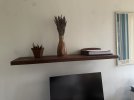Gene - For me, yes other side is finished - and this is drywall. I was hoping to do this without patching or painting.Is the other side of the wall accessible? Is the other side of the wall finished? If it is sheetrock pop some holes in it and screw in the floating shelf(yes) from the back. Patch some sheetrock.
I think I have my plan - I am mounting 6-8' bolts (that I have from old project) into a 1x1.5" cleat. Holes to be drilled in the shelf for the bolts, and the cleat to be screwed onto the wall. Pretty much my original plan (as pictured in the original post above), except I am adding the bolts as support. I may or may not mount these individual pieces up against the adjoining wall.

